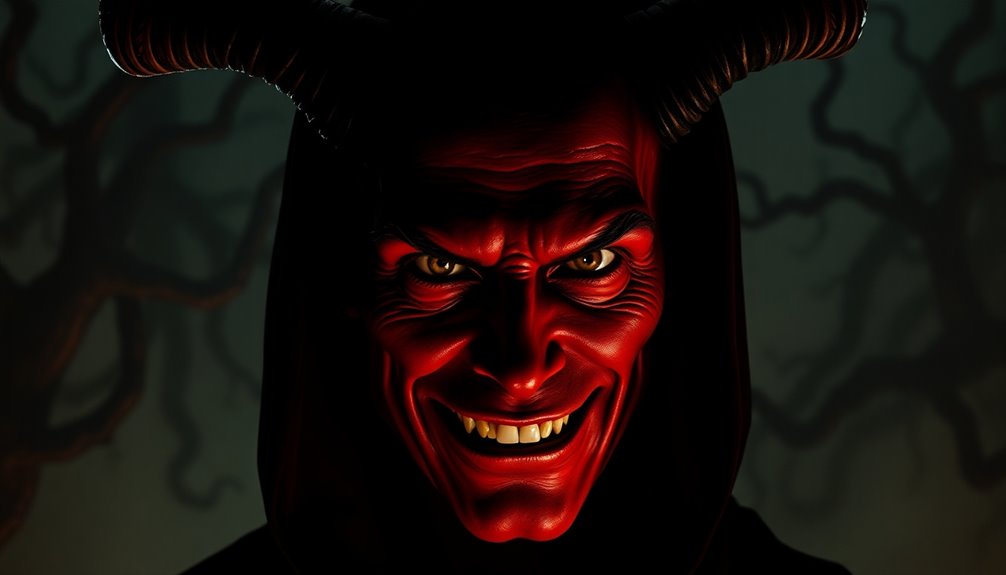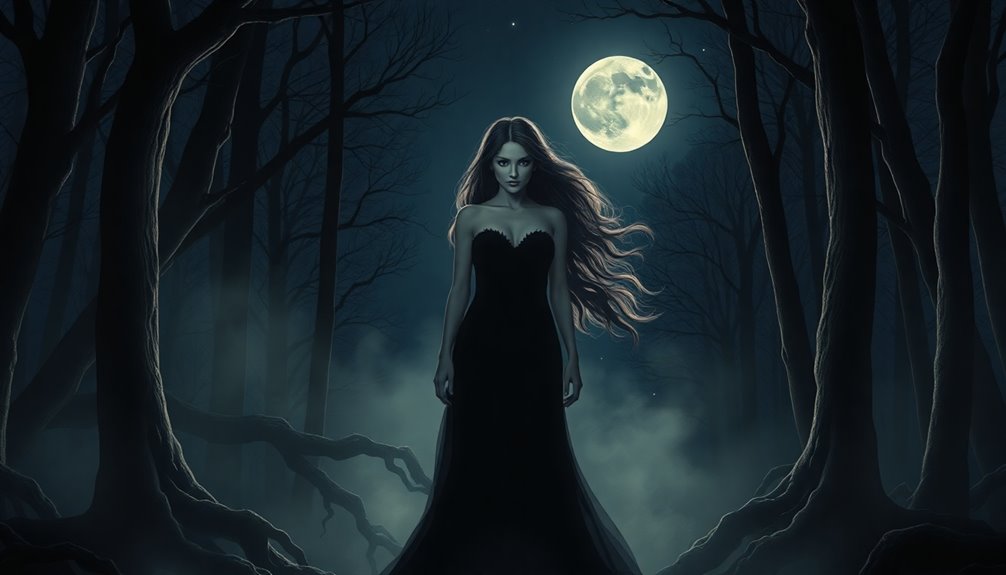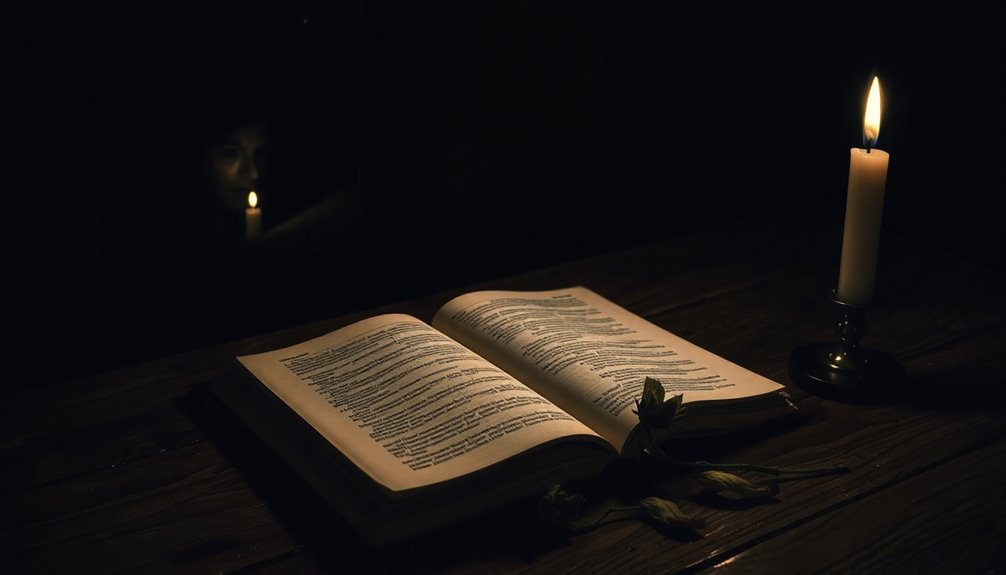Satan isn't just the terrifying figure with horns and a pitchfork you might picture. His true nature and appearance are much more intricate. The Bible describes him as an "angel of light," emphasizing his deceptive qualities over physical traits. Medieval art often portrayed him with goat-like features and grotesque traits, reflecting societal fears of the time. Yet, the scriptures highlight his cunning and manipulative essence rather than a clear image. Often, he embodies predatory behavior, like a roaring lion. If you're curious about how these depictions have evolved over time, there's much more to explore.
Key Takeaways
- The Bible does not provide a clear physical description of Satan, focusing instead on his deceptive and manipulative nature.
- Cultural depictions, influenced by medieval art, often portray Satan with horns, cloven hooves, and a pitchfork.
- John Milton's "Paradise Lost" presents Satan as a charismatic figure, contrasting biblical descriptions emphasizing his predatory character.
- Revelation 12:9 describes Satan as a "great dragon," symbolizing destruction rather than a specific physical form.
- Misconceptions about Satan's appearance arise from amalgamating features of pagan deities with Christian theology, distorting biblical truths.
Introduction
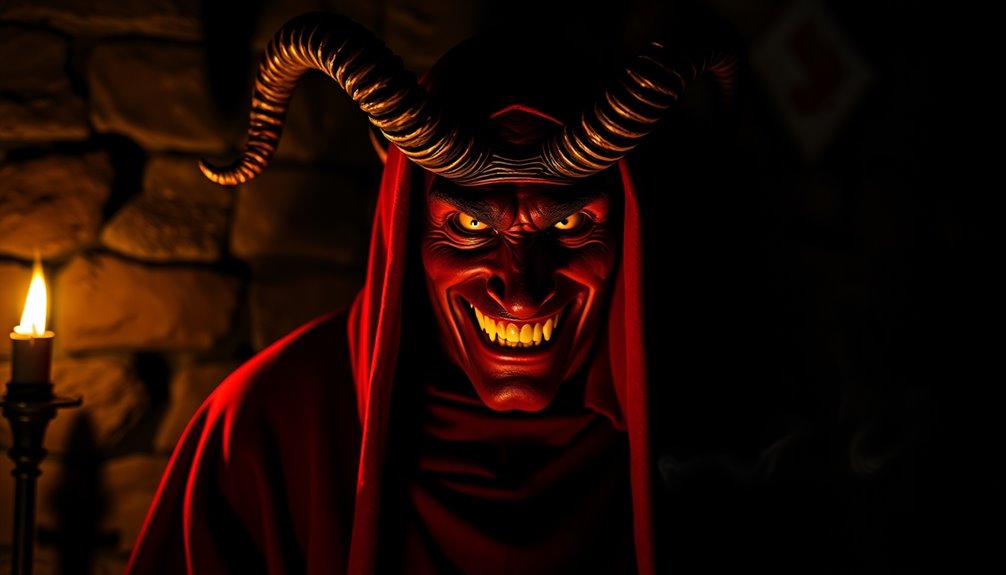
When you think about Satan, the first images that might come to mind are likely influenced by popular culture and art, rather than scripture. Common portrayals show him with horns, cloven hooves, and a pitchfork, but these depictions stem more from medieval art and mythology than from the Bible.
In reality, the scripture emphasizes Satan's deceptive nature rather than offering a definitive physical description. In 2 Corinthians 11:14, Satan is described as an angel of light, suggesting he can disguise himself as something alluring and good. This portrayal emphasizes the danger of underestimating him based on appearance alone.
Additionally, Ezekiel 28:12-15 hints at Satan's original beauty and glory, indicating that he was once a magnificent being before his fall. The artistic representations of Satan have shifted over time, often mixing features from various pagan deities.
This evolution has led to the modern image of a horned, demonic figure, which can distract from his true nature. Understanding these influences helps you see that Satan's real power lies in his cunning and deception, not in any specific look.
Biblical Descriptions of Satan
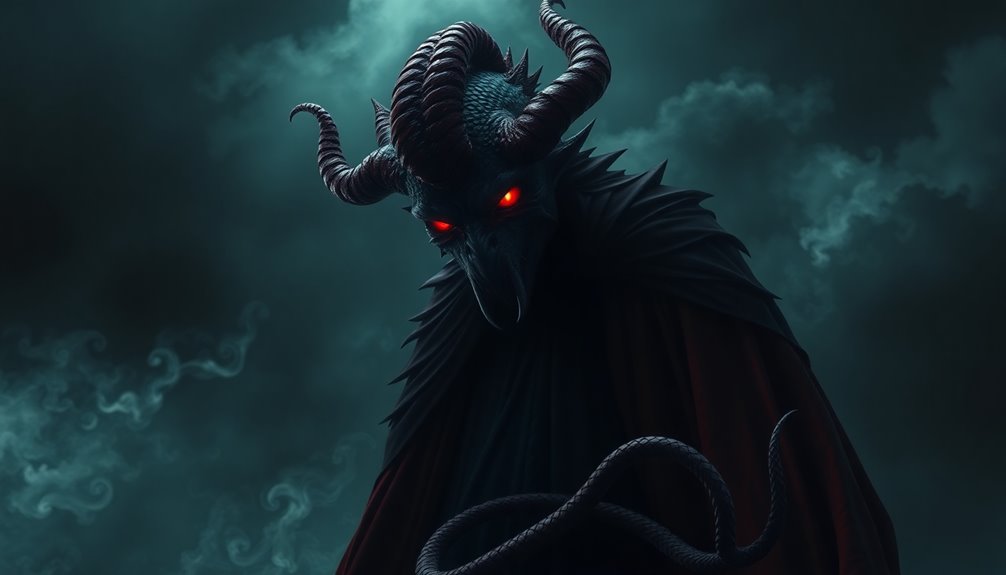
When you look at biblical descriptions of Satan, you'll notice the focus is more on his character than his appearance.
Key passages like Ezekiel 28 and Revelation 12 highlight his former beauty and current destructive nature, while others, like 1 Peter 5, emphasize his predatory behavior.
Let's explore these primary and secondary references to understand how the Bible portrays this enigmatic figure.
Primary Bible References
The Bible offers limited physical descriptions of Satan, focusing instead on his deceptive and malevolent nature. In 2 Corinthians 11:14, it states that Satan can transform himself into an angel of light, emphasizing his cunning ability to disguise himself. This highlights that Satan looks different than what you might expect, as he embodies temptation and deceit.
Ephesians 6:11-12 describes Satan as an invisible spirit being, reminding you that spiritual warfare is a crucial aspect of his character. Revelation 12:9 refers to him as a great dragon, symbolizing his fearsome and destructive nature rather than providing a physical form. This imagery serves to underline his role as a fallen angel, once beautiful and glorious, as noted in Ezekiel 28:12-15.
The serpent in Genesis is another representation often linked to Satan, illustrating his role in temptation. While the original Hebrew text doesn't name the serpent explicitly as Satan, the connection remains strong.
Ultimately, these primary Bible references emphasize that Satan's true essence lies in his malevolence, rather than a specific appearance.
Secondary Bible References
While the primary Bible references focus on Satan's nature, secondary descriptions further illustrate his character through various metaphors and symbols.
For instance, in 1 Peter 5:8, Satan is referred to as a roaring lion, emphasizing his role as a fierce adversary. This imagery captures his predatory instincts and intent to devour the unwary.
Similarly, Revelation 12:9 depicts him as a great dragon, symbolizing chaos and destruction, reinforcing the fear he instills.
Moreover, in Ezekiel 28:12-15, you learn about Satan's original beauty and glory. This passage suggests he was once an exalted being, reflecting his fall from grace and the deceptive nature he embodies.
Interestingly, while the Bible doesn't give a definitive physical description, it highlights that Satan often disguises himself as an angel of light (2 Corinthians 11:14). This duality illustrates his ability to masquerade as something good while harboring malicious intent.
Through these metaphors, you grasp that Satan's true appearance isn't merely physical; it's his cunning, manipulative nature that poses the greatest threat, reminding you to remain vigilant against his deceptions.
Medieval Art's Influence on Satan
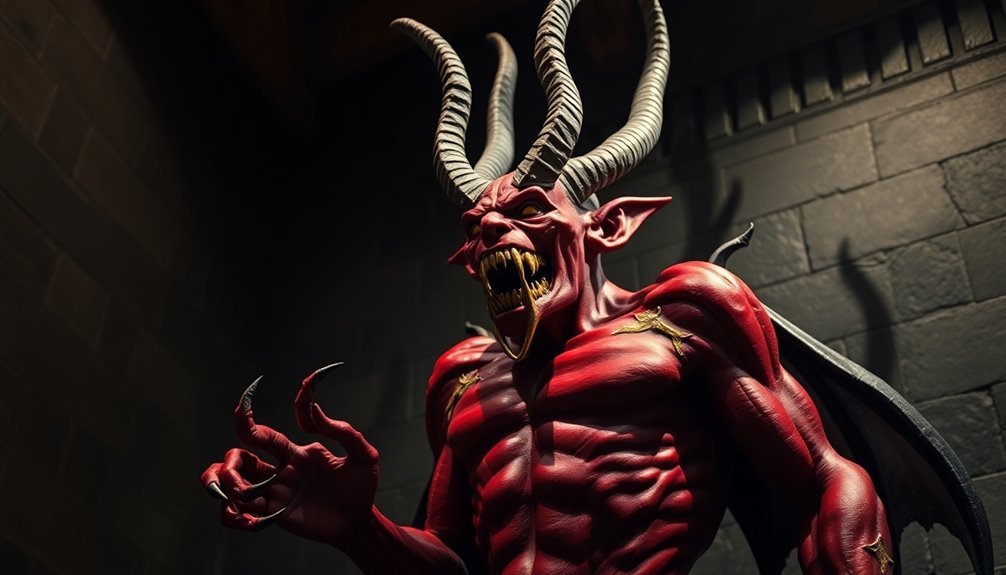
Influencing perceptions of evil, medieval art played a crucial role in shaping the image of Satan. Artists often depicted the devil with animalistic features like horns, cloven hooves, and a tail, drawing inspiration from cultural symbols of goats and other creatures tied to paganism. This portrayal evoked fear, making Satan appear as a terrifying figure meant to embody evil.
The Smithfield Decretals manuscript serves as a prime example, illustrating the devil with grotesque traits that reinforced societal fears and moral teachings. In this context, Satan's representation as a dragon or beast echoed biblical descriptions, emphasizing his role as an adversary of God and humanity.
As you explore these artworks, you'll notice how they amalgamated features from various pagan deities, creating a composite figure that intertwined ancient beliefs with Christian theology.
Through these artistic interpretations, the Church sought to communicate the nature of evil and the importance of resisting temptation. By visualizing fallen angels in such a monstrous way, medieval art not only shaped the image of Satan but also solidified the cultural understanding of the devil as a formidable opponent in the spiritual realm.
Symbolism in Artistic Representations

Artistic representations of Satan are rich with symbolism, each element carefully chosen to convey deeper meanings about good, evil, and the human condition. You'll often notice that Satan's appearance varies dramatically across different works.
For instance, medieval art frequently depicts him with goat-like features, such as horns and cloven hooves, drawing from biblical parables where goats symbolize the damned. This imagery emphasizes his role as the adversary of virtue.
In John Milton's "Paradise Lost," Satan is portrayed as a charismatic figure, adding layers of complexity to his character and challenging traditional notions of evil. Here, his beauty becomes a symbol of temptation, blurring the lines between good and bad.
Dante Alighieri's "Inferno" introduces another dimension with Satan's large bat-like wings, merging influences from Babylonian mythology and Greco-Roman depictions of the underworld, reinforcing his role as the ultimate outcast.
The modern red devil stereotype, popularized by theatrical productions like Gounod's "Faust," encapsulates the essence of temptation and sin, making Satan's appearance a powerful tool for conveying moral lessons.
Each artistic representation invites you to explore the duality of his character, reflecting humanity's ongoing struggle with good and evil.
Satan's Physical Appearance Myths
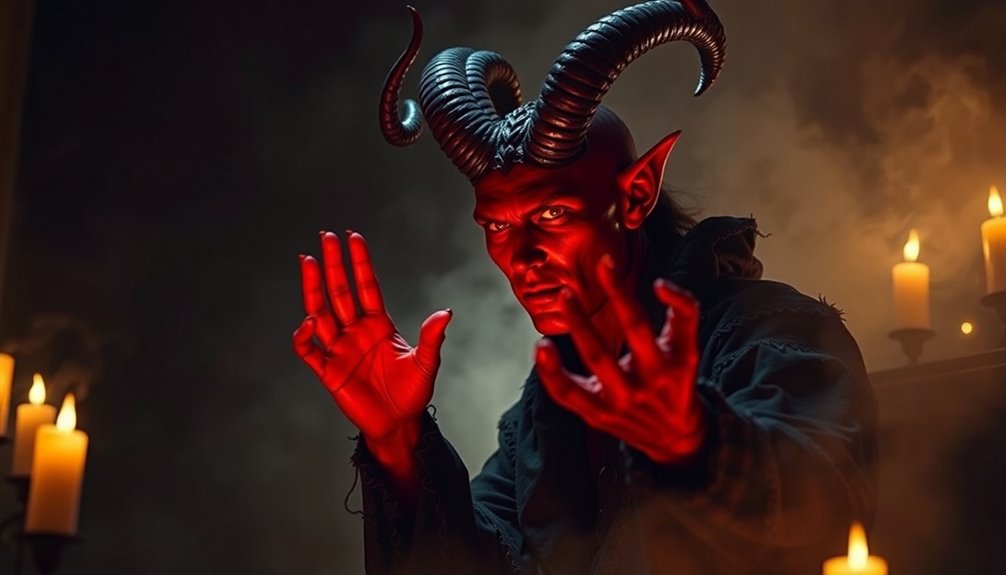
You might think you know what Satan looks like, but many common images are far from the truth.
Cultural interpretations and myths have shaped our view of him, often depicting a monstrous figure with horns and cloven hooves.
In reality, the Bible emphasizes his deceptive nature and doesn't provide a clear physical description, leaving much of what you see to artistic imagination.
Debunk Common Satan Misconceptions
Many misconceptions about Satan's appearance have popped up over the years, leading to a distorted image that often strays far from biblical truth. The Bible doesn't provide a physical description of Satan; instead, it emphasizes his deceptive actions and characteristics (2 Corinthians 11:14).
So, those common portrayals of Satan with horns and a pitchfork are more influenced by medieval art and mythology than by scripture.
When you hear that Satan is described as an "angel of light," it highlights his ability to disguise himself and mislead individuals. This deception is crucial to understand, as it shows that Satan's true nature isn't about a scary appearance but about his cunning and manipulative traits.
Many artistic depictions, such as the goat-like figure, stem from associations with pagan deities rather than any biblical basis.
Cultural Interpretations of Satan
Cultural interpretations of Satan have shaped his appearance in ways that often stray from biblical texts. Initially depicted as a beautiful angel in early Christian art, Satan's appearance evolved dramatically over time. Influenced by pagan deities like Pan, later representations introduced animalistic features, such as horns and cloven hooves. This goat-like imagery became prominent during medieval times, correlating with biblical parables where goats symbolize those excluded from heaven (Matthew 25).
John Milton's "Paradise Lost" added another layer, portraying Satan as a charismatic figure with human-like beauty, solidifying the idea of an attractive devil in popular culture.
Meanwhile, the iconic red devil stereotype—characterized by red skin and a pitchfork—gained traction from theatrical works like Gounod's opera "Faust," significantly impacting modern Halloween costumes and media portrayals.
Additionally, Dante's "Inferno" showcased Satan with large bat-like wings, drawing from various mythological sources.
These diverse cultural interpretations highlight how Satan's appearance has transformed through history, reflecting society's evolving fears, beliefs, and artistic expressions.
Ultimately, understanding these interpretations can provide insight into how we perceive the figure of Satan today.
Everyday Moral Decision-Making

Every day, you face ethical choices that shape not only your life but also the lives of those around you.
Engaging in discussions with your community can help clarify these moral dilemmas and expand your understanding.
Daily Ethical Choices
Making daily ethical choices can feel like navigating a complex maze, where each turn involves weighing personal values against potential consequences. You often find yourself confronted with dilemmas that test your moral compass. These ethical choices aren't just abstract ideas; they can devour your thoughts and impact your day-to-day life.
Cognitive biases, like the bystander effect, can distort your judgment, making it harder to act in alignment with your values. To combat this, it's essential to engage with different ethical frameworks, such as utilitarianism, which focuses on outcomes, or deontology, which emphasizes duties. By understanding these approaches, you can clarify your decision-making process.
Reflective practices, like journaling or discussing your dilemmas with trusted friends, can enhance your awareness and help you see your choices more clearly. Research shows that when you prioritize ethical decision-making, you not only experience greater personal satisfaction but also foster stronger relationships within your community.
Ultimately, by consistently making thoughtful ethical choices, you build a foundation of integrity that serves you well in every aspect of your life.
Community Ethical Discussions
In community ethical discussions, you find a valuable opportunity to explore the collective moral landscape that shapes your shared values and decisions. These conversations often center around principles like honesty and integrity, reflecting how you consider the impact of your choices on others' well-being.
As you engage in moral decision-making, you're encouraged to appreciate diverse perspectives and the potential consequences of your actions on the community.
Ethical dilemmas frequently surface in everyday situations, such as conflicts of interest. Here, you're faced with weighing personal benefits against the larger societal good.
To navigate these complexities effectively, active listening and effective communication are essential. They help create an environment where ethical concerns can be openly discussed and collaboratively resolved.
Incorporating frameworks for ethical decision-making, like case studies or moral theories, can be particularly helpful. For instance, during a Bible study, you might analyze how biblical principles apply to modern ethical dilemmas.
This approach not only enhances your understanding but also strengthens the community's moral fabric. Ultimately, these discussions empower you to make more informed, ethical choices that benefit everyone involved.
Cultural Evolution of Satan's Image
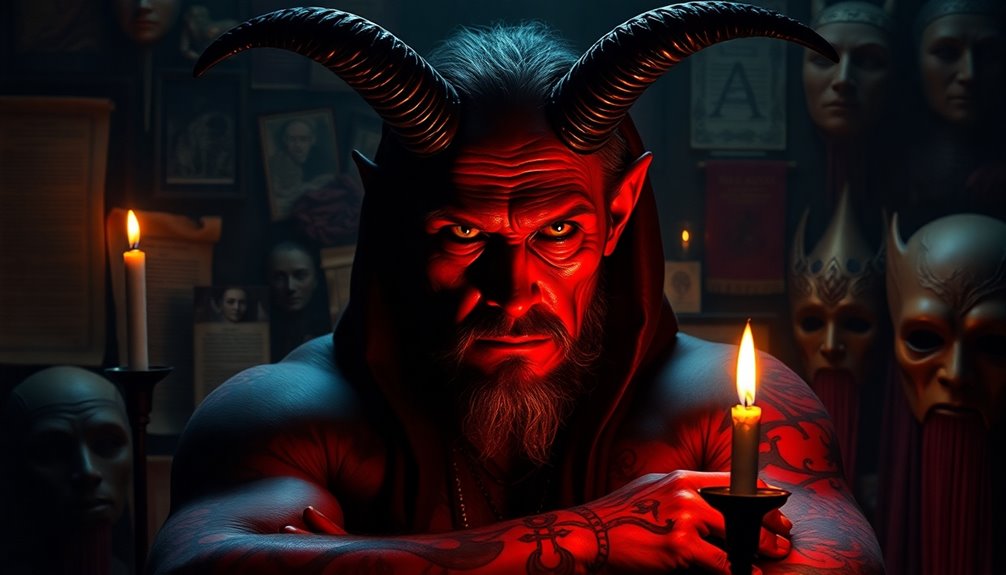
The image of Satan has undergone a remarkable transformation throughout history, shifting from an abstract representation in ancient texts to a vividly anthropomorphic figure in medieval art. Initially, Satan's appearance was more symbolic, but as cultural evolution took place, he became depicted with distinct features like horns and a tail, drawing inspiration from fertility deities such as Pan.
John Milton's "Paradise Lost," published in 1667, further shaped modern portrayals of Satan, presenting him as a complex and charismatic character. This characterization emphasized his beauty and tragic nature, influencing how people perceive him.
By the 19th and early 20th centuries, Satan's image took on a more commercial aspect, appearing in advertisements and cartoons, often depicted as a red, horned figure. Theater productions like Gounod's "Faust" popularized this stereotype, embedding it in the public consciousness.
Today, Satan's appearance continues to adapt, reflecting societal changes. You might encounter him as a child in "The Omen" or a businessman in various narratives, showcasing how our understanding of evil evolves.
This ongoing cultural evolution keeps the figure of Satan both relevant and multifaceted in contemporary discourse.
Additional Resources
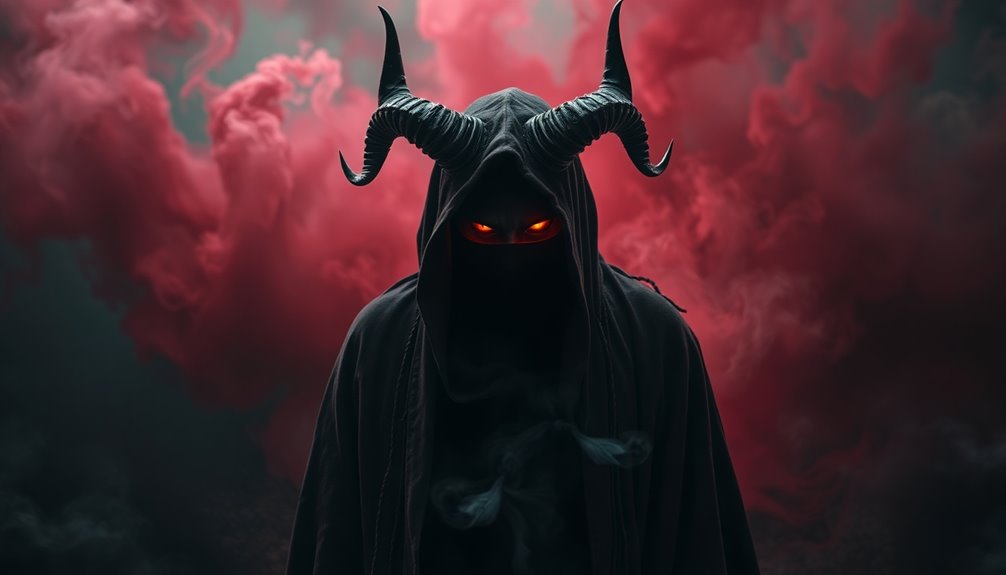
To dive deeper into the intriguing evolution of Satan's image, several resources can enhance your understanding. Start with the Bible itself, particularly 2 Corinthians 11:14, which emphasizes that Satan's deceptive nature is more critical than his physical description. This perspective can reshape your thinking about Satan's appearance, steering you away from traditional depictions.
Explore literary works like John Milton's "Paradise Lost." This epic poem paints Satan as an attractive, heroic figure, influencing modern cultural representations. You'll see how these portrayals contrast with biblical references, such as Ezekiel 28:12-15, which suggests he was once beautiful and glorious, yet now embodies a predatory essence.
For a more vivid understanding of his menacing nature, read 1 Peter 5:8, which describes Satan as a roaring lion seeking to devour. This metaphor highlights his threatening character rather than any specific physical features.
Lastly, consider examining historical art and cultural critiques that discuss how pagan influences shaped common artistic portrayals of Satan. By engaging with these resources, you'll gain a comprehensive view of how Satan's image has transformed over time.
Frequently Asked Questions
What Is Satan's Appearance in the Bible?
When you explore Satan's appearance in the Bible, you won't find a specific physical description.
Instead, the focus is on his deceptive nature and character. He's portrayed as a roaring lion seeking to devour, emphasizing danger.
In Revelation, he's depicted as a Great Red Dragon, showcasing fearfulness.
Importantly, he can disguise himself as an angel of light, highlighting his ability to mislead rather than providing a clear image of himself.
How Do Demons Look Like According to the Bible?
The Bible doesn't give a clear picture of how demons look. Instead, it emphasizes their spiritual nature.
You'll find that demons are often described as deceptive beings, capable of manipulating appearances to trick people. They can take on various forms, especially in apocalyptic visions, but these representations focus more on their evil actions than physical traits.
What Is Satan's Real Name?
Satan's real name originates from the Hebrew word "śāṭān," meaning "accuser" or "adversary."
You might also know him as "the Devil," derived from the Greek "diabolos," which translates to "slanderer."
In Islamic tradition, he's called "Iblis," a jinn who defied God's command to bow to Adam.
These names reflect his role as an opponent to both God and humanity throughout various religious texts and interpretations.
What Was Lucifer's Appearance?
When you consider Lucifer's appearance, you might envision a being of extraordinary beauty and brilliance.
In biblical texts, he's described as radiant, adorned with precious stones, and referred to as the "morning star." This majestic image emphasizes his original glory as an angel.
Over time, however, artistic interpretations shifted, depicting him with darker, more monstrous traits, ultimately transforming his image into one associated with rebellion and evil.

